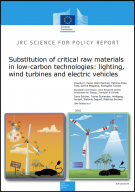Details
- Publication date
- 1 January 2016
- Author
- Joint Research Centre
Description
This report evaluates the substitution options of nine critical raw materials (CRM) (Eu, Tb, Y, In, Ga, Ge, Nd, Pr and Dy) required in lighting, wind turbines and electric vehicles applications. Substitution has been considered from many perspectives from reducing the use of CRM via improved material efficiency to substitution at material and component level.
Despite many years of research, the direct and complete replacement of the critical raw materials in phosphors, LEDs and permanent magnets by other more readily available and less critical materials is still not commercially available. However, substitution has the potential to reduce the future demand for CRM in the low-carbon technologies sector by improving material efficiency and component substitution.---
In the lighting sector, markets have begun to shift from fluorescent to light-emitting diode (LED) technology. This transition will lead to a decline in the demand for terbium, europium, yttrium and germanium by 2020, although demand for gallium and indium seems to be increasing. In organic-LED (OLED) technology, critical raw materials (with the exception of indium) are substituted by organic compounds. It is expected that OLED technology will widely penetrate the general lighting market after 2025, thereby further reducing the demand for phosphors and critical raw materials in lighting.
Due to concerns over the supply of rare earths, some wind manufacturers have started to develop, adopt or switch to alternative turbine technologies which rely on less rare earth or none at all. In parallel, research has made relevant progress in reducing the amount of heavy rare earths, such as dysprosium or terbium, in wind turbines. Most current wind turbines operate via traditional technologies without any rare earths. The future market share of different turbine types will depend to a large extent on the development of the price and technological advantages of rare earths. For offshore applications, a sector in which the EU is the leader, the direct drive permanent magnet synchronous generator (DD-PMSG), which contains rare earths, has demonstrated a number of advantages especially in terms of efficiency and lower maintenance. In order to maintain its leadership and competitiveness in the offshore wind sector, the EU should continue to invest in rare earth substitution while also adopting other measures to secure the supply of rare earths.
Currently, the permanent magnet synchronous traction motor (PSM) which contains rare earths is the technology of choice for electric vehicles. Alternative rare earth-free electric motors (e.g. asynchronous or electrically excited synchronous machines) exist for battery electric vehicles (BEVs). The lack of component substitution for PSM in the serial production of hybrid electric vehicles represents a major challenge because these models dominate the EVs sector today. However, there are a lot of substitution options available in R&D or pilot phases.

